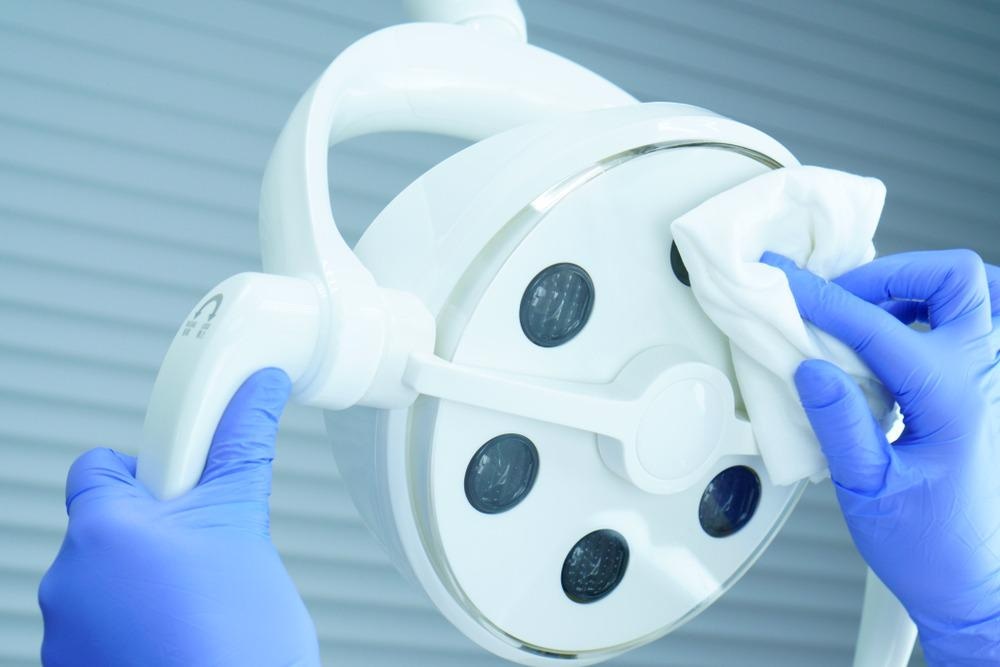For decades, cleaning and disinfection have been manual tasks in hospitals. However, the manual disinfection procedures impose a high risk of infection during the pandemic. Robotics technology is now providing a simple solution to these issues through the innovation and adoption of no-touch disinfection.

Image Credit: MODANO/Shutterstock.com
Challenges in Cleaning and Disinfecting Hospitals
Viruses and bacteria can survive on the surfaces of an object for several days in hospitals. In the healthcare environment, hospitals became a potential source of transmission of viruses and bacteria. Therefore, it has become increasingly important to effectively clean and disinfect the hospital environment.
Manual cleaning and disinfection are widely used in hospitals. However, manual cleaning is highly dependent on human behavioral factors. As it depends hugely on the individuals and their motivations, the efficacy of manual cleaning and disinfection are variable.
In addition, the shortage of resources such as labor and surface disinfectants during the pandemic impose further challenges to effectively carry out the cleaning and disinfection routines in hospitals.
Use of Robotics Technology to Battle Infectious Disease such as COVID-19
Disinfection robots use either ultraviolet-C (UV-C) light or hydrogen peroxide vapor (HPV) to disinfect the patient rooms, corridors, and other designated areas in the hospital.
The most widely used is UV-C radiation which works by deactivating the DNA and RNA. HPV kills microorganisms through the oxidative process. This mitigates the risk of infections acquired in the hospitals and reduces the cost by automating this laborious task. The robot also offers a non-touch solution that avoids the exposure of staff to harmful UV radiation during the cleaning process. It also provides real-time feedback of contamination levels in designated areas in the hospital to ensure a safe environment for patients and staff.
Where manual cleaning and disinfection cannot be eliminated, the robots can be used to provide additional hygiene care to reduce healthcare-associated infections.
How Disinfection Robots Work
The working mechanism of disinfection robots varies depending on the manufacturer.
The most effective UV disinfection robots with a wide spectrum and higher intensity are made by Xenex. With its patented Pulsed Xenon UV system, it requires a small exposure of UV light to kill viruses such as SARS-CoV-2 and other pathogens.
After the designated area is finished with standard cleaning procedures, Xenex’s disinfection robot called Violet can be set up to remove any germs left behind on all of the furniture and other surfaces.
Disinfection robots scan the designated area to ensure no presence of humans and then expand to its full height of 5-foot 2-inches. It then starts flashing UV rays several times. The UV rays are more intense than sunlight. Because it is so intense, it even works well in shaded areas. This incredibly intense light kills viruses, microorganisms, and pathogens on all surfaces. The disinfection robot takes around 5 to 10 minutes to finish the disinfection process.
This device was tested at Texas Biomedical Research in the United States. The results of the testing show that it has an efficacy of 99.99%. It reduced pathogen load in five minutes for N95 respirator masks and two minutes at 1 m for hard surfaces.
Limitations of Disinfection Robots
Although disinfection robots provide enormous benefits, they have their own limitations. Some of the hospital designs do not allow the robots to utilize their full potential. Due to this, navigating the complex and uncertain areas have been challenging for operating the disinfection robots.
Some companies use LiDAR technology to generate a map and SLAM to navigate through the paths to manoeuver disinfection robots in the hospital environment. However, the experts propose Type 1 and Type 2 Fuzzy Logic-based devices with wall following behaviors that can operate better in complex and uncertain environments. Some companies are also exploring the use of drone technologies to disinfect complex areas.
Fully trained experts are also required to set up the disinfection robots which imposes a challenge on resources. Although standardized disinfection robots are available to use, one size does not fit all. Hence, it requires some level of customization to fit the purpose of the hospital environment.
The Future of Robotics in Healthcare
The innovation in robotics is evolving over time and its application is increasingly becoming useful in various industries.
Healthcare is not an exception; the application of robotics technology is already widely used in the healthcare industry.
With the outbreak of the pandemic, the adoption of its application in areas such as cleaning and disinfection has increased in the healthcare industry.
The disinfection robots are also used in other high-traffic areas such as airports. However, there are some challenges to using disinfection robots in several hospital environments due to their design.
The continuous evolution of the technology can overcome its limitations to make it even easier to adopt disinfection robots to clean and disinfect in hospitals.
Continue reading: Robotic Healthcare: Integrating Robotics into Surgery
References and Further Reading
Michelle Doll, Stevens, M, and Bearman, G., (2018) Environmental cleaning and disinfection of patient areas, International Journal of Infectious Diseases, 67, pp.52-57. Available at: https://doi.org/10.1016/j.ijid.2017.10.014
Sujan Sarker, Lafifa Jamal, Syeda Faiza Ahmed, and Niloy Irtisam., (2021) Robotics and artificial intelligence in healthcare during COVID-19 pandemic: A systematic review, Robotics and Autonomous Systems, 146, 103902. Available at: https://doi.org/10.1016/j.robot.2021.103902
Zemmar, A., Lozano, A.M. & Nelson, B.J. (2020)The rise of robots in surgical environments during COVID-19. Nat Mach Intell 2, 566–572. Available at: https://doi.org/10.1038/s42256-020-00238-2
Diab-El Schahawi, M., Zingg, W., Vos, M. et al. (2021) Ultraviolet disinfection robots to improve hospital cleaning: Real promise or just a gimmick?. Antimicrob Resist Infect Control 10, 33. Available at: https://doi.org/10.1186/s13756-020-00878-4
Disclaimer: The views expressed here are those of the author expressed in their private capacity and do not necessarily represent the views of AZoM.com Limited T/A AZoNetwork the owner and operator of this website. This disclaimer forms part of the Terms and conditions of use of this website.